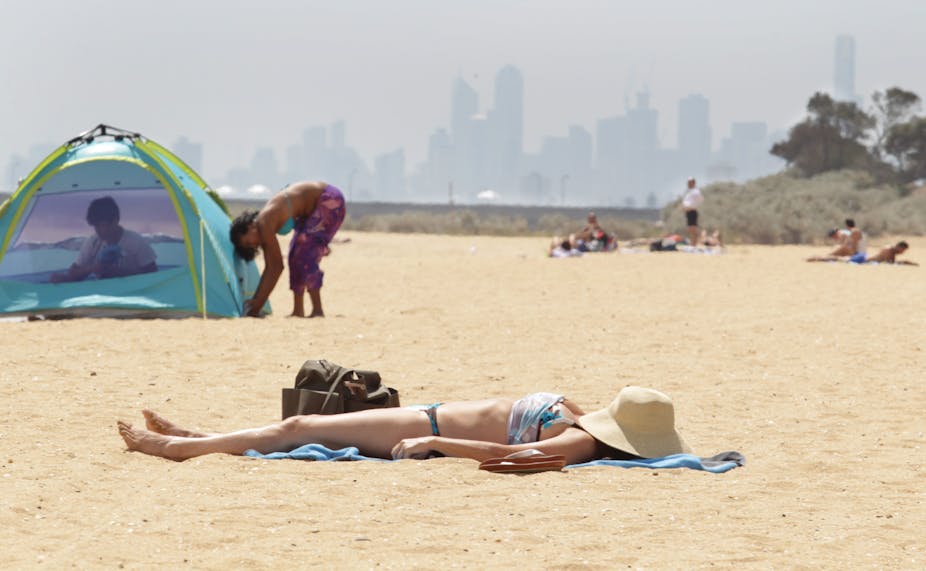The State of the Climate 2014 report, released today by the CSIRO and the Bureau of Meteorology, confirms that Australia is heating up. It has warmed by 0.9C since 1910, with more in store thanks to the carbon dioxide the world has already emitted.
As a result, severe heat events are becoming more frequent, and the climate drivers of bushfire activity are intensifying.
Other climate changes are also occurring, such as sea-level rise, ocean acidification, increasing tropical rainfall, and significant declines in winter rainfall in both the southwest and southeast of Australia over the past few decades.

But whereas the full impact of some of these changes may not be felt for some time to come, we are already seeing the impact of more severe heat events and more weather conducive to fire activity.
Heat events and bushfires already cause increased death and illness, as well as destroying property and damaging infrastructure. The recent increases in the climate drivers of severe heat events and bushfires have exacerbated the risks.
These heatwaves and bushfires are bringing home the reality of climate change. They affect Australian families and their homes – they are not something that happens to other people a long way away, or will happen to us a long time in the future. They are a clear and present danger to us, right now.
Beating the heat
Luckily, we are starting to adapt to these risks. After the record heatwave in Europe in 2003 that led to the death of many thousands of people, governments around the world intensified efforts to develop heatwave alert systems. A prototype Victorian heatwave alert system, based on research identifying the temperature threshold at which deaths start to happen, was in place just in time for the January 2009 heatwave.
Victoria’s heatwave alert system has since been further adapted and improved. In the days leading up to January’s significant heatwave in southeast Australia, the public was given a great deal of information about how to cope with the extreme heat, through the news media and other outlets.
This alert process was helped by the highly accurate temperature forecasts provided by the Bureau of Meteorology, which is now piloting a national heatwave alert service.
Heatwaves still kill too many people, and cause too much other damage and dislocation. But without the heatwave alerts and other adaptations already in place, the damage would be even greater.
Fiery future
With higher temperatures come more destructive bushfires. Governments, fire services and bureaucrats have been working together for several decades to improve how we tackle the increasing bushfire risk. The measures include banning the lighting of fires or the use of dangerous equipment on days with severe fire risk, increasing the equipment and personnel available to fight fires before they spread, and setting up targeted information campaigns to ensure that people understand the risks and what can be done to reduce them. True, these measures were not introduced specifically in response to global warming, but a warming climate makes them more necessary than ever.
As with heatwaves, bushfires still threaten lives and damage too much property. But without the efforts of fire services and others over recent years, the threat and damage would have been even greater.
We will need to intensify our adaptation efforts in the future because heatwaves are expected to increase still more in frequency and severity over the coming decades. The Intergovernmental Panel on Climate Change recently assessed the scientific literature regarding possible changes in a wide variety of climate and weather extremes. For many of these extremes – such as droughts, floods, and tropical cyclones – it is difficult to assess whether or not these have increased in recent decades or whether global warming will exacerbate them in the future. But there is much more certainty surrounding hot days and heatwaves.
The State of the Climate report highlights the ample evidence that the numbers of hot days and nights have increased in recent decades, and this has happened across the world, not just in Australia. There is considerable confidence among scientists that the frequency and severity of heatwaves will increase in the future, as greenhouse gas emissions continue to rise. Similarly, the report notes that the weather associated with enhanced bushfire risk is anticipated to continue to increase in coming decades.
Unknown territory
As global warming continues, this will push us into unknown territory. As we begin to experience heatwaves and bushfire risks that our current population has never before experienced, how do we even estimate how bad the impacts will be?
New record heatwaves and fire risks could push us into a truly catastrophic situation. We will need to rely on politicians, bureaucrats, the medical and fire services, and scientists to identify more ways to ensure communities, health services, and vulnerable people are better prepared for these changed conditions. Doing this will save lives now, as well as in the future, even if we do nothing to reduce our greenhouse gas emissions.
Of course, it will be easier to deal with this problem if politicians and industry also manage to slow the emissions of greenhouse gases. Anything they can do now to reduce emissions will reduce the chances of catastrophic heatwaves and bushfire risks in the future.

